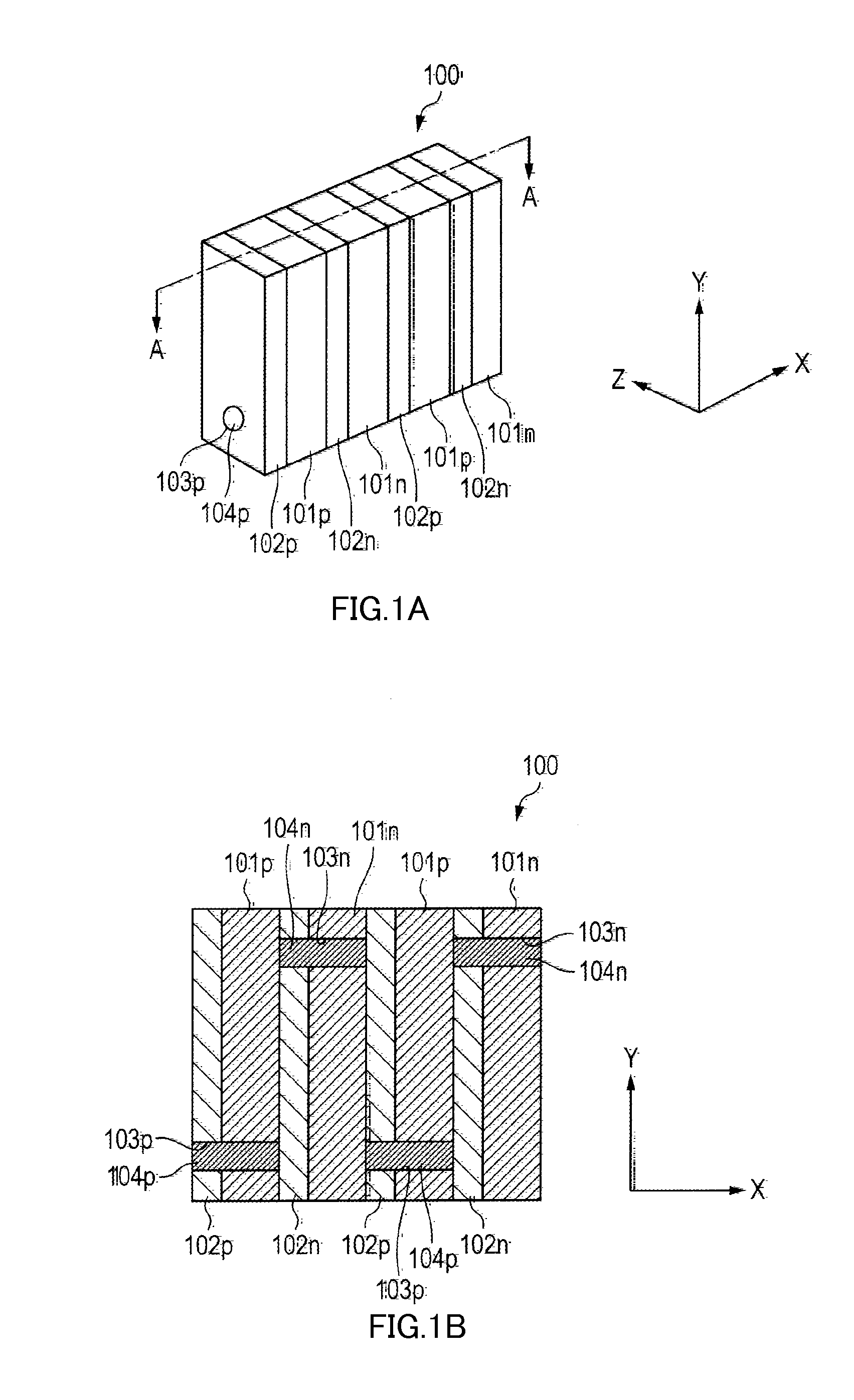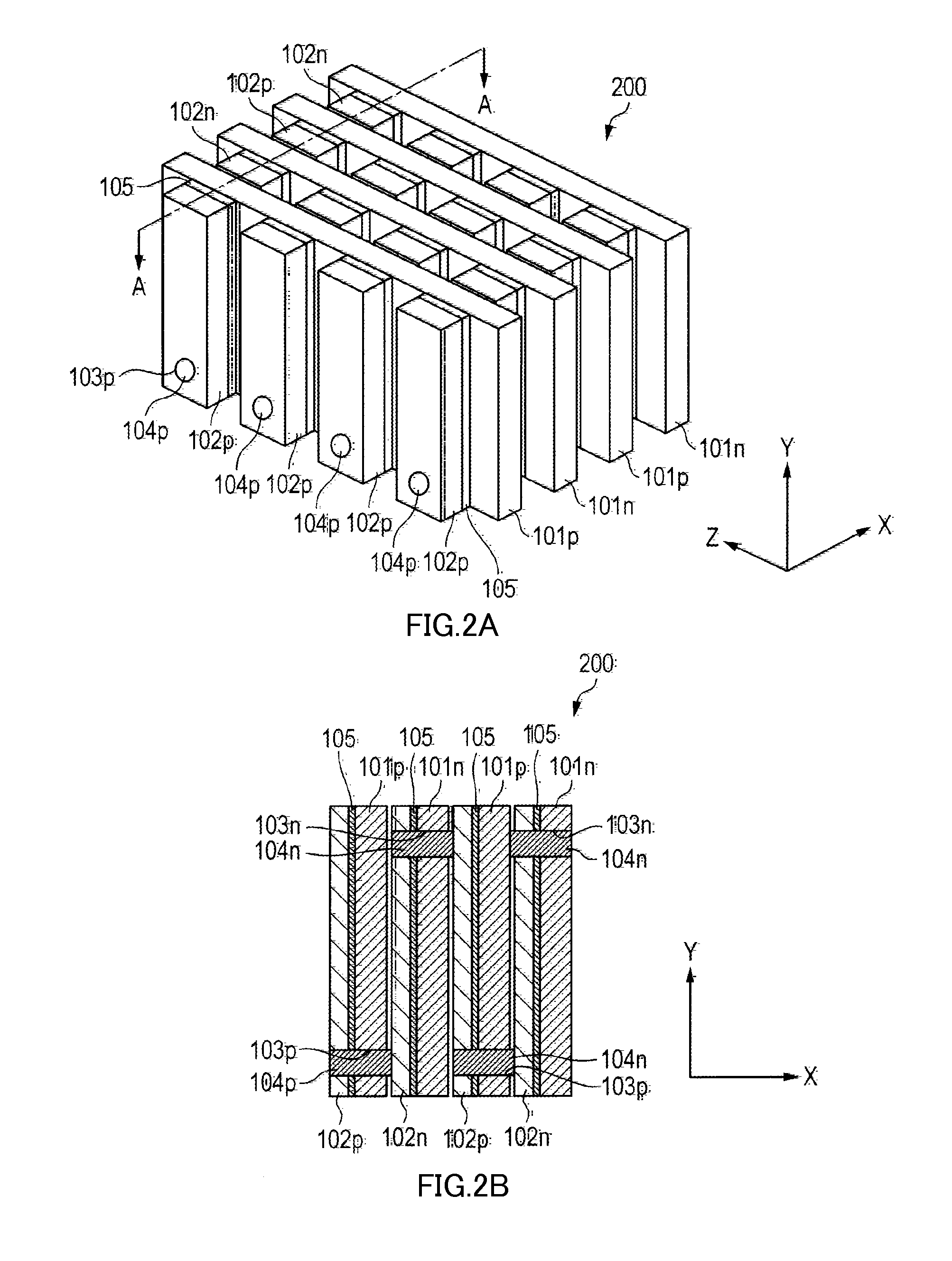Thermoelectric conversion element and producing method thereof
a technology of thermoelectric elements and conversion elements, which is applied in the manufacture/treatment of thermoelectric devices, thermoelectric devices with peltier/seeback effects, electrical apparatus, etc., can solve the problems of degrading the yield of thermoelectric materials, chip breaking during cutting, and significant deformation of yield, so as to reduce stress applied to each thermoelectric material layer, reduce the number of pn junction pairs per unit area, and suppress the breakage of thermoelectric material chips
- Summary
- Abstract
- Description
- Claims
- Application Information
AI Technical Summary
Benefits of technology
Problems solved by technology
Method used
Image
Examples
embodiment 1
[0063]FIG. 1 is a view illustrating a schematic configuration of thermoelectric conversion element 100 according to Embodiment 1 of the invention. FIG. 1(a) is a perspective view, and FIG. 1(b) is a sectional view taken on a line A-A of FIG. 1(a).
[0064]As illustrated in FIG. 1, thermoelectric conversion element 100 of Embodiment 1 includes plural substrates 101, and alternate layers of p-type thermoelectric material layer 102p and n-type thermoelectric material layer 102n. The plurality of substrates 101 are disposed between adjacent layers of p-type thermoelectric material layer 102p and n-type thermoelectric material layer 102n. The plurality of substrates 101 have contact holes 103 such that contact holes 103 are disposed alternately at opposite ends, in the direction perpendicular to the direction of arrangement of p-type thermoelectric material layer 102p and n-type thermoelectric material layer 102n, of substrates 101. In FIG. 1, the sign X designates the direction of arrangem...
embodiment 2
[0089]FIG. 2 is a view illustrating a schematic configuration of thermoelectric conversion element 200 according to Embodiment 2 of the invention. FIG. 2(a) is a perspective view, and FIG. 2(b) is a sectional view taken on a line A-A of FIG. 2(a).
[0090]As illustrated in FIG. 2, plural substrates 101p and plural substrates 101n are alternately disposed in thermoelectric conversion element 200 of Embodiment 2. P-type thermoelectric material layer 102p is formed in the surface of each of substrates 101p, and n-type thermoelectric material layer 102n is formed in the surface of each of substrates 101n. Plural segments of p-type thermoelectric material layer 102p are formed in one substrate 101p. Plural segments of n-type thermoelectric material layer 102n are formed in one substrate 101n. As illustrated in FIG. 2(a), p-type thermoelectric material layers 102p and n-type thermoelectric material layers 102n are respectively arrayed in the Z-direction on each substrate 101. Each segments o...
embodiment 3
[0118]In the thermoelectric conversion element of the invention, the p-type thermoelectric material layers and the n-type thermoelectric material layers are alternately disposed along the X-direction, the disposition of the contact hole may vary in the Y-direction, and the disposition of the thermoelectric material layer may vary in the Z-direction on the same substrate.
[0119]For example, in thermoelectric conversion element 300 illustrated in FIG. 5, p-type thermoelectric material layers 102p and n-type thermoelectric material layers 102n are alternately arrayed along the X-direction. On one substrate 101′, segments of p-type thermoelectric material layers 102p and segments of n-type thermoelectric material layers 102n are alternately disposed along the Z-direction, respectively. For example: a segment of p-type thermoelectric material layer 102p that includes contact hole 103p on one end side in the Y-direction; a segment of n-type thermoelectric material layer 102n that includes ...
PUM
 Login to View More
Login to View More Abstract
Description
Claims
Application Information
 Login to View More
Login to View More - R&D
- Intellectual Property
- Life Sciences
- Materials
- Tech Scout
- Unparalleled Data Quality
- Higher Quality Content
- 60% Fewer Hallucinations
Browse by: Latest US Patents, China's latest patents, Technical Efficacy Thesaurus, Application Domain, Technology Topic, Popular Technical Reports.
© 2025 PatSnap. All rights reserved.Legal|Privacy policy|Modern Slavery Act Transparency Statement|Sitemap|About US| Contact US: help@patsnap.com



